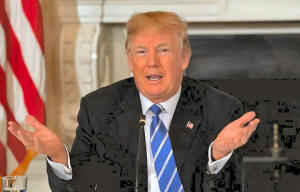|
Trump unveils infrastructure plan; uphill
battle awaits in Congress
 Send a link to a friend
Send a link to a friend
 [February 13, 2018]
By David Shepardson [February 13, 2018]
By David Shepardson
WASHINGTON (Reuters) - President Donald
Trump unveiled a long-awaited infrastructure plan on Monday designed to
encourage spending on improvements by states, localities and private
investors, but it faces an uphill battle in Congress and he made remarks
that called into question how hard he will fight for it.
Trump asked Congress, controlled by his fellow Republicans, to authorize
$200 billion over 10 years to spur a projected $1.5 trillion in road,
bridge and other projects to rebuild what he called "America's crumbling
infrastructure."
The proposal came under immediate fire from Democrats who said it would
put a huge burden on local governments without providing enough federal
dollars, and administration officials acknowledged that it faces a tough
road ahead.
Trump, who as a candidate promised a major infrastructure plan, said he
looked forward to working with lawmakers, but added, "If for any reason
they don't want to support it, hey, that's going to be up to them."

"What was very important to me was the military. What was very important
to me was the tax cuts. And what was very important to me was
regulation. This is of great importance, but it's not nearly in that
category," Trump told a meeting of state and local officials at the
White House.
The plan, which Trump called the "biggest and boldest infrastructure
investment in American history," would reshape how the federal
government funds infrastructure projects. It also seeks to sweep away
environmental and other regulatory hurdles to new projects.
If the proposal comes to fruition, many Americans could face higher
local taxes, fees and tolls imposed by states to pay for new repairs in
order to get federal matching funds.
The proposal is intended to spur state and local governments and the
private sector to increase spending on infrastructure without a major
infusion of federal dollars. It offers relatively little in the way of
new federal money considering the magnitude of infrastructure needs, and
its $1.5 trillion projection relies on states and cities accepting far
less in matching funds for infrastructure projects than they would
receive for traditional federal funds.
The plan also calls for eliminating hurdles to selling federal property
and lists as examples of potential properties to sell Reagan National
Airport and Dulles International Airport in Washington's Virginia
suburbs as well as two key roadways in the Washington region operated by
the National Park Service.
Under the proposal, the Interior Department could tap some funds from
energy and mineral extraction to pay for infrastructure improvements on
government-owned land such as national parks.
Trump has made his infrastructure plan one of his top legislative
priorities this year, ahead of the November mid-term congressional
elections in which Democrats will try to take over control of Congress
from his party.
Democrats said the administration's budget blueprint would actually cut
at least $168 billion in planned infrastructure spending to pay for the
proposal.
[to top of second column]
|

President Donald Trump holds a meeting on his infrastructure
initiative at the White House in Washington, U.S., February 12,
2018. REUTERS/Kevin Lamarque

Representative Peter DeFazio, the top Democrat on the House of
Representatives Transportation and Infrastructure Committee, called
Trump's proposal "embarrassingly small," adding, "President Trump's
plan slashes real federal investments and shifts the burden to
cash-strapped states and local governments."
DeFazio said it would "pay for Wall Street and foreign investors to
toll our roads, and it would gut bedrock environmental, clean water,
and clean air protections under the guise of speeding up projects."
'MAGICAL THINKING'
Democratic Senator Richard Blumenthal said Trump's plan "relies on
magical thinking, massive private profits, and a pittance of public
investment."
U.S. Transportation Secretary Elaine Chao told reporters that the
government should lift hurdles to private sector infrastructure
funding and encourage state and local participation. The federal
government cannot do it alone, she said.
"Unfortunately there's not enough money to be able to pay for all
the infrastructure needs of our country," Chao said.
The plan does not offer nearly as much new federal funding as
Democrats wanted nor does it directly address how the federal
government will find the money it does call for, instead pointing to
a variety of proposed cuts in its budget released on Monday. The
administration called the proposal a starting point for
negotiations.

The Republican chairman of the House Energy and Commerce Committee,
Greg Walden, said in a joint statement with fellow Republicans that
"Trump hit the nail on the head when constructing this plan to
rebuild America's infrastructure."
Congress has not raised the gas since 1993 and has added $137
billion since 2008 to make up highway repair shortfalls. Congress
must find another $107 billion through 2026 alone to keep spending
at current levels.
Trump met at the White House with state and local officials
including the governors of Wisconsin, Louisiana, Virginia and Maine
on Monday, and was due to meet with congressional leaders on
Wednesday on the proposal.
(Reporting by Will Dunham)
[© 2018 Thomson Reuters. All rights
reserved.]
Copyright 2018 Reuters. All rights reserved. This material may not be published,
broadcast, rewritten or redistributed.
Thompson Reuters is solely responsible for this content. |